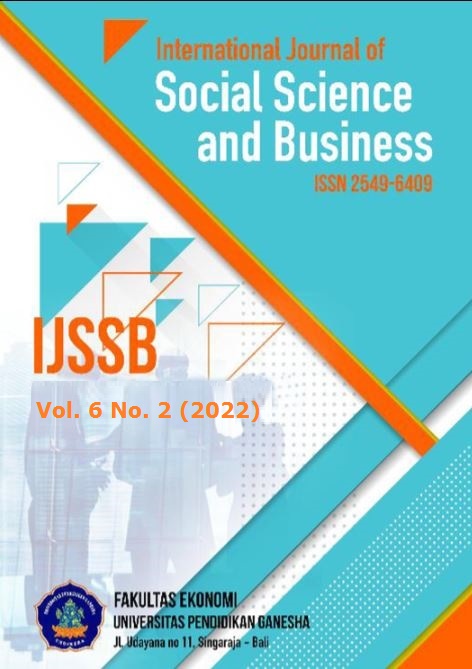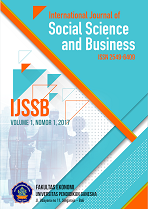The Toxicity of our City: The Effect of Toxic Workplace Environment on Employee’s Performance
DOI:
https://doi.org/10.23887/ijssb.v6i2.45297Keywords:
Toxic workplace environment, green management, employee performance, human resource managementAbstract
In serving taxpayers, SAMSAT must pay attention to environmental comfort. However, an explanation regarding the Samsat topic, especially in the public service sector. This study aims to analyze the effect of the work environment on the performance of SAMSAT employees in Maros Regency. The method used is quantitative with a descriptive approach. This research is quantitative research with a Likert scale type of questionnaire. 31 SAMSAT employees of Maros Regency were recruited as respondents. The instrument validity test uses item analysis and is calculated using the product-moment formula, while the reliability test uses Cronbach's Alpha formula. Prerequisites of analysis include normality test and linearity test. The results showed that the work environment in SAMSAT Maros Regency was in a suitable category, namely 60.22% from 100%. The results of the study indicate that the workplace environment shapes employee performance. In addition, a toxic work environment will harm employee performance and lead to work outcomes. It is more likely to be experienced by junior employees. Therefore, to overcome this problem, many strategies can be done to overcome this problem. One strategy is for organizational leaders to support employees by acknowledging their problems at work and providing essential assistance, especially for tasks with more stressful requirements.
References
Abadi, R. R., Nursyamsi, I., & Syamsuddin, A. R. (2020). Effect of Customer Value and Experiential Marketing to Customer Loyalty with Customer Satisfaction as Intervening Variable (Case Study on GoJek Makassar Consumers). The Asian Journal of Technology Management, 13(1). https://doi.org/10.12695/ajtm.2020.13.1.6. DOI: https://doi.org/10.12695/ajtm.2020.13.1.6
Anjum, A., Ming, X., Siddiqi, A. F., & Rasool, S. F. (2018). An empirical study analyzing job productivity in toxic workplace environments. International journal of environmental research and public health, 15(5). https://doi.org/10.3390/ijerph15051035. DOI: https://doi.org/10.3390/ijerph15051035
Audenaert, M., Decramer, A., & George, B. (2021). How to foster employee quality of life: The role of employee performance management and authentic leadership. Evaluation and Program Planning, 5. https://doi.org/10.1016/j.evalprogplan.2021.101909. DOI: https://doi.org/10.1016/j.evalprogplan.2021.101909
Bangwal, D., & Tiwari, P. (2019). Workplace environment, employee satisfaction and intent to stay. International Journal of Contemporary Hospitality Management, 319(1). https://doi.org/10.1108/IJCHM-04-2017-0230. DOI: https://doi.org/10.1108/IJCHM-04-2017-0230
Boye, K., & Grönlund, A. (2018). Workplace skill investments–an early career glass ceiling? Job complexity and wages among young professionals in Sweden. Work, Employment and Society, 32(2). https://doi.org/10.1177/0950017017744514. DOI: https://doi.org/10.1177/0950017017744514
Braun, V., & Clarke, V. (2021). To saturate or not to saturate? Questioning data saturation as a useful concept for thematic analysis and sample-size rationales. Qualitative research in sport, exercise and health, 13(2). https://doi.org/10.1080/2159676X.2019.1704846. DOI: https://doi.org/10.1080/2159676X.2019.1704846
Budiyanti, H., Patiro, S. P., & Nurman, N. (2018). Organizational justice perception of Indonesia civil servants, does it matter? Jurnal Ekonomi Dan Bisnis, 21(2). https://doi.org/10.24914/jeb.v21i2.2017. DOI: https://doi.org/10.24914/jeb.v21i2.2017
Delios, A., Perchthold, G., & Capri, A. (2021). Cohesion, COVID-19 and contemporary challenges to globalization. Journal of World Business, 56(3). https://doi.org/10.1016/j.jwb.2021.101197. DOI: https://doi.org/10.1016/j.jwb.2021.101197
Delmas, M. A., & Pekovic, S. (2018). Organizational configurations for sustainability and employee productivity: A qualitative comparative analysis approach. Business & Society, 57(1). https://doi.org/10.1177%2F0007650317703648. DOI: https://doi.org/10.1177/0007650317703648
Diamantidis, A. D., & Chatzoglou, P. (2018). Factors affecting employee performance: an empirical approach. International Journal of Productivity and Performance Management, 68(1). https://doi.org/10.1108/IJPPM-01-2018-0012. DOI: https://doi.org/10.1108/IJPPM-01-2018-0012
Dipoatmodjo, T. S. P., Kurniawan, A. W., & Haeruddin, M. I. M. (2021). Pengaruh Motivasi dan Lingkungan Kerja terhadap Kinerja Karyawan CV. Ibunda di Kota Makassar. Jurnal Manajemen, 1(2). DOI: https://doi.org/10.36355/jms.v1i1.475
Firmansyah, A., Maupa, H., Taba, I., & Hardiyono, H. (2020). The Effect of Work Motivation, Work Environment, and Work Discipline on Employees’ Performance of SAMSAT Office, Makassar. Hasanuddin Journal of Business Strategy, 2(2). https://doi.org/10.26487/hjbs.v2i2.336. DOI: https://doi.org/10.26487/hjbs.v2i2.336
George, B., Walker, R. M., & Monster, J. (2019). Does strategic planning improve organizational performance? A meta‐analysis. Public Administration Review, 79(6). https://doi.org/10.1111/puar.13104. DOI: https://doi.org/10.1111/puar.13104
Ginting, F. C. B., Lubis, S., & Asmara, S. (2022). The Effect of Interpersonal Communication of Tax Service Officers on the Perception and Level of Taxpayer Satisfaction at KPP Pratama Lubuk Pakam. Budapest International Research and Critics Institute (BIRCI-Journal): Humanities and Social Sciences, 5(2). https://doi.org/10.33258/birci.v5i2.4608.
Green, C. (2021). The hollow: A theory on workplace bullying in nursing practice. Nursing forum, 56(2). https://doi.org/10.1111/nuf.12539. DOI: https://doi.org/10.1111/nuf.12539
Haeruddin, M. I. M., Kurniawan, A. W., Akbar, A., Burhanuddin, B., Dipoatmodjo, T., & Mustafa, M. Y. (2021). Holier than Thou: A Comparative Study of Leader-Member Exchange (LMX) Effectiveness in Transactional and Transformational Leadership in IT Companies. Jurnal Ad’ministrare, 8(1). https://doi.org/10.26858/ja.v8i1.24027. DOI: https://doi.org/10.26858/ja.v8i1.24027
Khan, S., & Mohiya, M. (2020). Determinants of SMEs employees’ creativity and their impact on innovation at workplace. Management Science Letters, 10(16). https://doi.org/10.5267/j.msl.2020.7.025. DOI: https://doi.org/10.5267/j.msl.2020.7.025
Kurniawaty, K., Ramly, M., & Ramlawati, R. (2019). The effect of work environment, stress, and job satisfaction on employee turnover intention. Management Science Letters, 9(6). https://doi.org/10.5267/j.msl.2019.3.001. DOI: https://doi.org/10.5267/j.msl.2019.3.001
Lakens, D. (2022). Sample size justification. Collabra: Psychology, 8(1). https://doi.org/10.1525/collabra.33267. DOI: https://doi.org/10.1525/collabra.33267
Lee, P., Joo, S. H., & Lee, S. (2019). Examining stability of personality profile solutions between Likert-type and multidimensional forced choice measure. Personality and Individual Differences, 142. https://doi.org/10.1016/J.PAID.2019.01.022. DOI: https://doi.org/10.1016/j.paid.2019.01.022
Majid, U. (2018). Research fundamentals: Study design, population, and sample size. Undergraduate Research in Natural and Clinical Science and Technology Journal, 2. https://doi.org/10.26685/urncst.16. DOI: https://doi.org/10.26685/urncst.16
Martin, W., & LaVan, H. (2010). Workplace bullying: A review of litigated cases. Employee Responsibilities and Rights Journal, 22(3). https://doi.org/10.1007/s10672-009-9140-4. DOI: https://doi.org/10.1007/s10672-009-9140-4
Michalak, R. T., & Ashkanasy, N. M. (2020). Working with monsters: counting the costs of workplace psychopaths and other toxic employees. Accounting & Finance, 60(1). https://doi.org/10.1111/acfi.12369. DOI: https://doi.org/10.1111/acfi.12369
Narasuci, W., Setiawan, M., & Noermijati, N. (2018). Effect of work environment on lecturer performance mediated by work motivation and job satisfaction. Jurnal Aplikasi Manajemen, 16(4). https://doi.org/10.21776/ub.jam.2018.016.04.11. DOI: https://doi.org/10.21776/ub.jam.2018.016.04.11
Nguyen, P. T., Yandi, A., & Mahaputra, M. R. (2020). Factors that influence employee performance: motivation, leadership, environment, culture organization, work achievement, competence and compensation (A study of human resource management literature studies). Dinasti International Journal of Digital Busin. Management, 1(4). https://doi.org/10.31933/dijdbm.v1i4.389.
Pratama, A. B. (2019). The landscape of public service innovation in Indonesia: A comprehensive analysis of its characteristic and trend. Innovation & Management Review, 17(1). https://doi.org/10.1108/INMR-11-2018-0080. DOI: https://doi.org/10.1108/INMR-11-2018-0080
Puspitaningtyas, Z., & Kurniawan, A. W. (2016). Metode Penelitian Kuantitatif. Pandawa Buku.
Rasool, S. F., Wang, M., Tang, M., Saeed, A., & Iqbal, J. (2021). How toxic workplace environment effects the employee engagement: the mediating role of organizational support and employee wellbeing. International journal of environmental research and public health, 18(5). https://doi.org/10.3390/ijerph18052294. DOI: https://doi.org/10.3390/ijerph18052294
Raziq, A., & Maulabakhsh, R. (2015). Impact of working environment on job satisfaction. Procedia Economics and Finance, 23. https://doi.org/10.1016/S2212-5671(15)00524-9. DOI: https://doi.org/10.1016/S2212-5671(15)00524-9
Savavibool, N. (2020). Effects of color schemes on aesthetic response of the work environment. Kasetsart Journal of Social Sciences, 41(3). https://doi.org/10.34044/j.kjss.2020.41.3.20. DOI: https://doi.org/10.34044/j.kjss.2020.41.3.20
Savavibool, N., Gatersleben, B., & Moorapun, C. (2016). The effects of colour in work environment: A systematic review. Environment-Behaviour Proceedings Journal, 1(4). https://doi.org/10.21834/e-bpj.v1i4.167. DOI: https://doi.org/10.21834/e-bpj.v1i4.167
Schleu, J. E., & Hüffmeier, J. (2021). Simply the best? A systematic literature review on the predictive validity of employee performance for leader performance. Human Resource Management Review, 31(2). https://doi.org/10.1016/j.hrmr.2020.100777. DOI: https://doi.org/10.1016/j.hrmr.2020.100777
Smith, N., & Fredricks-Lowman, I. (2020). Conflict in the workplace: a 10-year review of toxic leadership in higher education. International Journal of Leadership in Education, 23(5). https://doi.org/10.1080/13603124.2019.1591512. DOI: https://doi.org/10.1080/13603124.2019.1591512
Sürücü, L., & Maslakçi, A. (2020). Validity and reliability in quantitative research. Business & Management Studies: An International Journal, 8(3). https://doi.org/10.15295/bmij.v8i3.1540. DOI: https://doi.org/10.15295/bmij.v8i3.1540
Suzuki, K., & Demircioglu, M. A. (2021). Is impartiality enough? Government impartiality and citizens’ perceptions of public service quality. Governance, 34(3). https://doi.org/10.1111/gove.12527. DOI: https://doi.org/10.1111/gove.12527
Teoh, K. B., Cordova, M., Hor, S. N., Lim, C. H., Yeoh, L. K., Madhu, A., Warrier, U., Chan, J., Kee., D., Florence, E., Chia, J., & Chuah, Y. J. (2021). The factors of employee performance: A study of SearchNEasy. Asia Pacific Journal of Management and Education (APJME), 4(1). https://doi.org/10.32535/apjme.v4i1.1053. DOI: https://doi.org/10.32535/apjme.v4i1.1053
Thomas, B. J., & Meglich, P. (2019). Justifying new employees’ trials by fire: workplace hazing. Personnel Review, 48(2). https://doi.org/10.1108/PR-01-2018-0025. DOI: https://doi.org/10.1108/PR-01-2018-0025
Tran, K. T., Nguyen, P. V., Dang, T. T., & Ton, T. N. (2018). The impacts of the high-quality workplace relationships on job performance: A perspective on staff nurses in Vietnam. Behavioral Sciences, 8(12). https://doi.org/10.3390/bs8120109. DOI: https://doi.org/10.3390/bs8120109
Wang, T. K., & Brower, R. (2019). Job satisfaction among federal employees: The role of employee interaction with work environment. Public Personnel Management, 48(1). https://doi.org/10.1177%2F0091026018782999. DOI: https://doi.org/10.1177/0091026018782999
Yarberry, S., & Sims, C. (2021). The impact of Covid-19 prompted virtual/remote work environments on employees’ career development: Social learning theory, belongingness, and self-empowerment. Advances in Developing Human Resources, 23(3). https://doi.org/10.1177/15234223211017850. DOI: https://doi.org/10.1177/15234223211017850
Downloads
Published
How to Cite
Issue
Section
License
Copyright (c) 2022 M. Ikhwan Maulana Haeruddin, Abdi Akbar, Tenri SP Dipoatmodjo, Agung Widhi Kurniawan, Rahmat Riwayat Abadi

This work is licensed under a Creative Commons Attribution-ShareAlike 4.0 International License.











